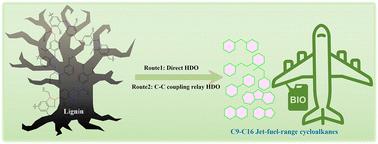催化木质素及其衍生物加氢脱氧和 C-C 偶联生成可再生喷气燃料级环烷烃
IF 9.2
1区 化学
Q1 CHEMISTRY, MULTIDISCIPLINARY
引用次数: 0
摘要
碳原子数为 C9-C16 的环烷烃是理想的喷气燃料成分,主要通过石油衍生苯的加氢反应和线性烷烃的环化反应合成。木质素及其衍生物本身具有碳环结构,将其催化转化为喷气燃料范围内的环烷烃已被证明是一条潜在的绿色经济路线,可提高可持续航空燃料(SAF)的可持续性并减少整体温室气体排放。直接加氢脱氧(HDO)和 C-C 偶联中继加氢脱氧是利用木质素及其衍生物生产环烷烃的两条主要路线。在这篇综述中,首先将木质素 C-O 衍生物在金属酸催化剂上的 HDO 转化为单环烷烃作为一个模型反应,以了解不可或缺的 HDO 过程的催化结构-活性关系。然后,讨论了通过对实际木质素同时进行解聚和 HDO 来生产木质素航空燃料,接着讨论了 C-C 偶联接替脱氢制取多环烷烃的路线,包括烷基化接替脱氢路线、醛醇缩合接替脱氢路线和一锅转化路线。此外,本文还试图强调尚存在的挑战,并为未来设计特定结构的环烷烃提供一些展望,旨在为可行地利用木质素获得 C9-C16 理想喷气燃料范围的环烷烃提供启示。本文章由计算机程序翻译,如有差异,请以英文原文为准。

Catalytic hydrodeoxygenation and C–C coupling of lignin and its derivatives into renewable jet-fuel-range cycloalkanes
Cycloalkanes with the carbon numbers C9–C16 are ideal jet-fuel components and are mainly synthesized by the hydrogenation of petroleum-derived benzenes and the cyclization reactions of linear alkanes. The catalytic conversion of lignin and its derivatives, intrinsically embodying carbocyclic structures, to jet-fuel-range cycloalkanes has been demonstrated as a potential green and economical route, which can improve the sustainability of sustainable aviation fuels (SAFs) as well as reduce the overall greenhouse gas emissions. Direct hydrodeoxygenation (HDO) as well as C–C coupling relay hydrodeoxygenation are the two main routes for the production of cycloalkanes from lignin and its derivatives. In this review, first, the HDO of lignin C–O derivatives to monocycloalkanes over metal–acid catalysts was considered a model reaction to provide an understanding of the catalytic structure–activity relationship of the indispensable HDO process. Then, the production of lignin jet fuel via the simultaneous depolymerization and HDO of real lignin was discussed, followed by the C–C coupling relay hydrodeoxygenation route for polycycloalkanes production, including the alkylation relay hydrodeoxygenation route, aldol condensation relay hydrodeoxygenation route and one-pot conversion route. Furthermore, this paper attempts to highlight the remaining challenges and provide some perspectives for the future design of structure-specific cycloalkanes, aiming to provide insights into the viable utilization of lignin to obtain C9–C16 ideal jet-fuel-range cycloalkanes.
求助全文
通过发布文献求助,成功后即可免费获取论文全文。
去求助
来源期刊

Green Chemistry
化学-化学综合
CiteScore
16.10
自引率
7.10%
发文量
677
审稿时长
1.4 months
期刊介绍:
Green Chemistry is a journal that provides a unique forum for the publication of innovative research on the development of alternative green and sustainable technologies. The scope of Green Chemistry is based on the definition proposed by Anastas and Warner (Green Chemistry: Theory and Practice, P T Anastas and J C Warner, Oxford University Press, Oxford, 1998), which defines green chemistry as the utilisation of a set of principles that reduces or eliminates the use or generation of hazardous substances in the design, manufacture and application of chemical products. Green Chemistry aims to reduce the environmental impact of the chemical enterprise by developing a technology base that is inherently non-toxic to living things and the environment. The journal welcomes submissions on all aspects of research relating to this endeavor and publishes original and significant cutting-edge research that is likely to be of wide general appeal. For a work to be published, it must present a significant advance in green chemistry, including a comparison with existing methods and a demonstration of advantages over those methods.
 求助内容:
求助内容: 应助结果提醒方式:
应助结果提醒方式:


